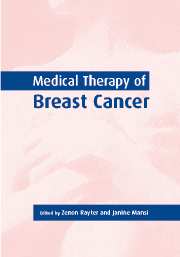Book contents
- Frontmatter
- Contents
- List of contributors
- 1 History of breast cancer therapy
- 2 Chemoprevention of breast cancer
- 3 Familial breast cancer
- 4 Hormone replacement therapy and breast cancer
- 5 Screening for breast cancer
- 6 The management of in situ breast cancer
- 7 Adjuvant systemic therapy
- 8 Adjuvant radiotherapy in the management of breast cancer
- 9 Predictors of response and resistance to medical therapy
- 10 Primary medical therapy in breast cancer
- 11 Medical therapy of advanced disease
- 12 Experimental approaches
- 12a High-dose chemotherapy in breast cancer
- 12b New immunological approaches to treatment for breast cancer
- 13 The place of bisphosphonates in the management of breast cancer
- 14 Palliative care in breast cancer
- Index
12b - New immunological approaches to treatment for breast cancer
Published online by Cambridge University Press: 06 January 2010
- Frontmatter
- Contents
- List of contributors
- 1 History of breast cancer therapy
- 2 Chemoprevention of breast cancer
- 3 Familial breast cancer
- 4 Hormone replacement therapy and breast cancer
- 5 Screening for breast cancer
- 6 The management of in situ breast cancer
- 7 Adjuvant systemic therapy
- 8 Adjuvant radiotherapy in the management of breast cancer
- 9 Predictors of response and resistance to medical therapy
- 10 Primary medical therapy in breast cancer
- 11 Medical therapy of advanced disease
- 12 Experimental approaches
- 12a High-dose chemotherapy in breast cancer
- 12b New immunological approaches to treatment for breast cancer
- 13 The place of bisphosphonates in the management of breast cancer
- 14 Palliative care in breast cancer
- Index
Summary
Introduction
In spite of numerous advances that have been made in the screening and management of patients with breast cancer, an unacceptable number of patients die of this disease even though they may have had optimal therapy and management. It is therefore necessary to assess the possible impact of different treatment modalities currently used more in other tumour types and consider this application to the treatment of breast cancer. These include immunotherapy (active: vaccines, and passive: antibodies), gene therapy, antisense technology and antiangiogenic agents.
Cancer and the immune system
Macfarlane Burnet (1970) postulated that the immune system kept potential cancer cells under surveillance and could detect and kill thousands of emerging cancer cells every day. This concept had gradually fallen out of favour as regards the common solid tumours as they do not appear to be increased in conditions where the immune system is compromised, such as autoimmune deficiency syndrome (AIDS) and renal transplant patients. However, both of these conditions have an increased incidence of viral driven cancers such as Epstein–Barr Virus (EBV) associated lymphomas and HHV-8-associated Kaposi's sarcoma. In these conditions there is a foreign viral antigen(s) which can be detected and contained by a healthy immune system and the failure to do so leads to viraldriven proliferation and oncogenesis. The absence of increased breast, lung and bowel cancer in HIV infection however, does not mean that the immune system has no role in containment of tumour progression.
- Type
- Chapter
- Information
- Medical Therapy of Breast Cancer , pp. 329 - 339Publisher: Cambridge University PressPrint publication year: 2003



